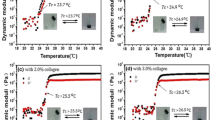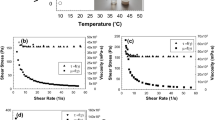Abstract
The present paper regards the preparation and characterization of Pluronic F127 + F68/water/poly (ε-caprolactone) microcapsules (MCs) composite systems for tissue repair. The first part of the work relates to the production of poly(ε-caprolactone) (PCL) MCs via water-in-oil-in-water (W/O/W) double emulsion system combined with solvent evaporation method. The study of different process parameters in the final MCs characteristics and their drug release profile is herein reported. Different percentages of PCL, emulsion stabilizer, and volume proportions of the emulsion constituents have been tested, leading to considerable differences in the MCs size distributions. The selected MCs, containing an aqueous solution of methylene blue (MB) as a model drug, were then used to fill a Pluronic F127 + F68/water system leading to the final composite system (5 and 10 wt % MB loaded PCL MCs). The composite systems were characterised in the second part of the work in terms of its rheological behaviour and drug release performance. They were found to gellify at 30 °C, and present an extended drug release to a total of 18 days. The models that best define the release profiles were also studied, with the release of MB occurring mostly by Fick diffusion and polymer chain relaxation. Pluronic F127 + F68/water/poly (ε-caprolactone) MCs composite system is shown to be a promising injectable system, with two different drug release rates, for tissue repair.










Similar content being viewed by others
References
Kan GM (2001) Controlled release oral dosage forms: some recent advances in matrix type drug delivery systems. J Med Sci 1:350–354
Tomaro-Duchesneau C, Saha S, Malhotra M, Kahouli I, Prakash S (2013) Microencapsulation for the therapeutic delivery of drugs, live mammalian and bacterial cells, and other biopharmaceutics: current status and future directions. J Pharm. https://doi.org/10.1155/2013/103527
Varde NK, Pack DW (2004) Microcapsules for controlled release drug delivery. Expert Opin Biol Ther 4:35–41
Davoodi P, Lee LY, Xu Q, Sunil V, Sun Y, Soh S, Wang C-H (2018) Drug delivery systems for programmed and on-demand release. Adv Drug Deliv Rev 132:104–138
Wang X, Wang Y, Wei K, Zhao N, Zhang S, Chen J (2009) Drug distribution within poly(ε-caprolactone) microcapsules and in vitro release. J Mater Process Technol 209:348–354
Pohlmann AR, Fonseca FN, Paese K, Detoni CB, Coradini K, Beck RC, Guterres SS (2013) Poly(e-caprolactone) microcapsules and nanocapsules in drug delivery. Expert Opin Drug Deliv 10:623–638
Iqbal M, Valour J-P, Fessi H, Elaissari A (2015) Preparation of biodegradable PCL particles via double emulsion evaporation method using ultrasound technique. Colloid Polym Sci 293:861–873
Lamprecht A, Ubrich N, Pérez MH, Lehr C-M, Hoffman M, Maincent P (2000) Influences of process parameters on nanoparticle preparation performed by a double emulsion pressure homogenization technique. Int J Pharm 196:177–182
Hwang Y-M, Pan C-T, Lin Y-M, Zeng S-W, Yen C-K, Wang S-Y, Kuo S-W, Ju S-P, Liang S-S, Liu Z-H (2019) Preparation of biodegradable polycaprolactone microcarriers with doxorubicin hydrochloride by ultrasonic-assisted emulsification technology. Sens Mater 31:301–310
Imbrogno A, Dragosavac MM, Piacentini E, Vladisavljević GT, Holdich RG, Giorno L (2015) Polycaprolactone multicore-matrix particle for the simultaneous encapsulation of hydrophilic and hydrophobic compounds produced by membrane emulsification and solvent diffusion processes. Colloids Surf B Biointerfaces 135:116–125
Yang Y-Y, Chung T-S, Ng N-P (2001) Morphology, drug distribution, and in vitro release profiles of biodegradable polymeric microcapsules containing protein fabricated by double-emulsion solvent extraction/evaporation method. Biomaterials 22:231–241
Seifriz W (1925) Studies in Emulsions III-V. J Phys Chem 29:738–749
Cesari A, Loureiro MV, Vale M, Yslas EI, Dardanelli M, Marques AC (2020) Polycaprolactone microcapsules containing citric acid and naringin for plant growth and sustainable agriculture physico-chemical properties and release behaviour. Sci Total Environ 703:135548. https://doi.org/10.1016/j.scitotenv.2019.135548
Loureiro MV, Vale M, Galhano Lopes R, Matos S, Bordado JC, Pinho I, Marques AC (2020) Microencapsulation of isocyanate in biodegradable poly(ε-caprolactone) capsules and application in monocomponent green adhesives. ACS Appl Polym Mater 2(11):4425–4438. https://doi.org/10.1021/acsapm.0c00535
Ibraheem D, Iqbal M, Agusti G, Fessi H, Elaissari A (2014) Effects of process parameters on the colloidal properties of polycaprolactone microparticles prepared by double emulsion like process. Colloids Surf A Physicochem Eng Asp 445:79–91. https://doi.org/10.1016/j.colsurfa.2014.01.012
Caramella C, Conti B, Modena T, Ferrari F, Bonferoni MC, Genta I, Rossi S, Torre ML, Sandri G, Sorrenti M, Catenacci L, Dorati R, Tripodo G (2016) Controlled delivery systems for tissue repair and regeneration. J Drug Deliv Sci Technol 32:206–228
Wang P, Johnston TP (1991) Kinetics of sol-to-gel transition for poloxamer polyols. J Appl Polym Sci 43:283–292
Zhang Y, Song W, Geng J, Chitgupi U, Unsal H, Federizon J, Rzayev J, Sukumaran DK, Alexandridis P, Lovell JF (2016) Therapeutic surfactant-stripped frozen micelles. Nat. Commun. 7(1):1–9
Zhang Y, Wang D, Goel S, Sun B, Chitgupi U, Geng J, Sun H, Barnhart TE, Cai W, Xia J (2016) Surfactant-stripped frozen pheophytin micelles for multimodal gut imaging. Adv Mater 28:8524–8530
Hoffman AS (2012) Hydrogels for biomedical applications. Adv Drug Deliv Rev 64:18–23
Peppas NA, Bures P, Leobandung W, Ichikawa H (2007) Hydrogels in pharmaceutical formulations. Eur J Pharm Biopharm 50:27–46
Gnavi S, Di Blasio L, Tonda-Turo C, Macardi A, Primo L, Ciardelli G, Gambarotta G, Geuna S, Perroteau I (2014) Gelatin based hydrogels as delivery systems for vascular endothelial growth factor release in peripheral nerve tissue engineering. J Tissue Eng Regen Med 11:459–470
Tonda-Turo C, Gnavi S, Ruini F, Gambarotta G, Gioffredi E, Chiono V, Perroteau I, Ciardelli G (2014) Development and characterisation of novel agar and gelatin injectable hydrogel as filler for peripheral nerve guidance channel. J Tissue Eng Regen Med 11(197):208
Tan H, Marra KG (2010) Injectable, biodegradable hydrogels for tissue engineering applications. Materials 3:1746–1767
Tipton AJ (2000) Dunn, In situ gelling systems. In: Senior J, Radomsky ML (eds) Sustained-release injectable products, 1st edn. CRC Press, Boca Raton, FL, USA, pp 241–278
Hollister LE (1989) Site-specific drug delivery to CNS: Old and new. Neurobiol Aging 10:631
Alexandridis P, Hatton TA (1995) Poly (ethylene oxide)- poly (propylene oxide)- poly (ethylene oxide) block copolymer surfactants in aqueous solutions and at interfaces: thermodynamics, structure, dynamics, and modeling. Colloids Surf A 96:1–46
Wanka G, Hoffmann H, Ulbricht W (1994) Phase diagrams and aggregation behavior of poly (oxyethylene)-poly (oxypropylene)-poly (oxyethylene) triblock copolymers in aqueous solutions. Macromolecules 27:4145–4159
Zhang M, Djabourov M, Bourgaux C, Bouchemal K (2013) Nanostructured fluids from pluronic® mixtures. Int J Pharm 454:599–610
Al Khateb K, Ozhmukhametova EK, Mussin MN, Seilkhanov SK, Rakhypbekov TK, ManLau W, Khutoryanskiy VV (2016) In situ gelling systems based on Pluronic F127/Pluronic F68 formulations for ocular drug delivery. Int J Pharm 502:70–79
Cidade MT, Ramos DJ, Santos J, Carrelo H, Calero N, Borges JP (2019) Injectable hydrogels based on pluronic/water systems filled with alginate microparticles for biomedical applications. Materials 12:1083
Weidenauer U, Bodmer D, Kissel T (2003) Microencapsulation of hydrophilic drug substances using biodegradable polyesters. Part I: evaluation of different techniques for the encapsulation of pamidronate disodium salt. J Microencapsul. 20:509–524
Zhou J, Fang T, Wen J, Shao Z (2011) Silk coating on poly(ε-caprolactone) microcapsules for the delayed release of vancomycin. J Microencapsul 28:99–107
Yu X, Wang N, Lv S (2016) Crystal and multiple melting behaviors of PCL lamellae in ultrathin films. J Cryst Growth 438:11–18
Smith B (2017) The carbonyl group, part I: introduction. Spectroscopy 32:31–36
Elzein T, Nasser-Eddine M, Delaite C, Bistac S, Dumas P (2004) FTIR study of polycaprolactone chain organization at interfaces. J Colloid Interface Sci 273:381–387
Ovchinniko OV, Evtukhova AV, Kondratenko TS, Smirnov MS, Khokhlov VY, Erina OV (2016) Manifestation of intermolecular interactions in FTIR spectra of methylene blue molecules. Vib Spectrosc 86:181–189
Xia Y, Yao Q, Zhang W, Zhang Y, Zhao M (2015) Comparative adsorption of methylene blue by magnetic baker’s yeast and EDTAD-modified magnetic baker’s yeast: equilibrium and kinetic study. Arab J Chem 12:2448–2456
Batenburg LF, Fischer H (2001) PlanoColors® a combination of organic dyes and layered silicates with nanometer dimensions. e-Polymers
Lu X, Katz JS, Schmitt AK, Moore JS (2018) A robust oil-in-oil emulsion for the nonaqueous encapsulation of hydrophilic payloads. J Am Chem Soc 140:3619–3625
Calero N, Santos J, Echevarría C, Muñoz J, Cidade MT (2018) Time-dependent behavior in analyte-, temperature-, and shear-sensitive pluronic pe9400/water systems. Colloid Polym Sci 296:1515–1522
Lau BK, Wang Q, Sun W, Li L (2004) Micellization to gelation of a triblock copolymer in water: thermoreversibility and scaling. J Polym Sci B 42:2014–2025
Acknowledgements
The authors gratefully acknowledge Fundacão para a Ciência e a Tecnologia (FCT) through the support of CERENA (Strategic Project FCT-UIDB/04028/2020) and Cenimat/I3N (Reference UID/CTM/50025/2019) and the FCT Grant SFRH/BD/140700/2018 (M.V.L.).
Author information
Authors and Affiliations
Corresponding author
Ethics declarations
Conflict of interest
The authors declare that they have no conflict of interest.
Additional information
Handling Editor: Lisa White.
Publisher's Note
Springer Nature remains neutral with regard to jurisdictional claims in published maps and institutional affiliations.
Rights and permissions
About this article
Cite this article
Delgado, B., Carrêlo, H., Loureiro, M.V. et al. Injectable hydrogels with two different rates of drug release based on pluronic/water system filled with poly(ε-caprolactone) microcapsules. J Mater Sci 56, 13416–13428 (2021). https://doi.org/10.1007/s10853-021-06156-x
Received:
Accepted:
Published:
Issue Date:
DOI: https://doi.org/10.1007/s10853-021-06156-x




